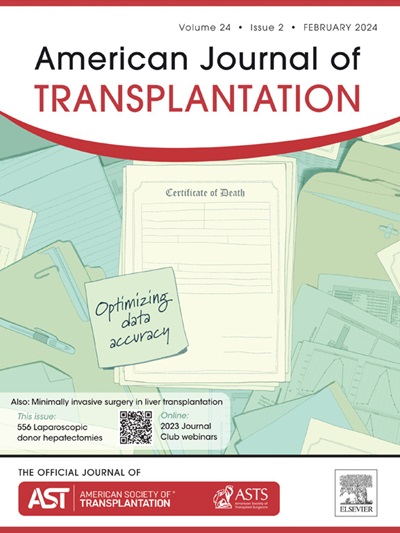OPTN/SRTR 2023 Annual Data Report: Kidney
IF 8.9
2区 医学
Q1 SURGERY
引用次数: 0
Abstract
In 2023, the field of kidney transplantation faced both successes and challenges. A record 28,142 total kidney transplants were achieved in the United States, largely due to an increase in deceased donor kidney transplants (DDKTs). While the number of adult candidates listed for DDKT slightly increased, it remained below the level in 2019, with 11.4% of candidates waiting 5 years or more. Across racial and ethnic groups, Black adult candidates had the largest increase in DDKT rate in 2023, in parallel with the Organ Procurement and Transplantation Network policy to modify waiting time (implemented January 5, 2023). Following increases in death rates during the COVID-19 pandemic, pretransplant mortality declined in 2023 across various age, race and ethnicity, sex, and blood type categories, although mortality continued to vary substantially by donation service area. The rate of deceased donor kidneys that were recovered for transplant but not transplanted (nonuse) increased to a notable high of 27.9%, from 26.6% in 2022, with even higher rates for biopsied kidneys (41.4%), those from donors aged 65 years or older (72.2%), and kidneys with a kidney donor profile index of 85% or higher (72.5%). In contrast, nonuse of kidneys recovered from hepatitis C virus nucleic acid test–positive donors declined to 27.2% in 2023, from 43.0% in 2017, likely reflecting more common use of protocols incorporating direct-acting antiviral therapy. Disparities in access to living donor kidney transplant (LDKT) persist and particularly affect non-White and publicly insured patients. Delayed graft function has risen over the past decade, but appears to have plateaued, at 26.1% overall for adult recipients in 2023. Five-year graft survival rates were 90.0% for LDKT compared with 82.2% for DDKT in recipients aged 18-34 years, and 80.2% for LDKT versus 66.1% for DDKT in those aged 65 years or older.

求助全文
约1分钟内获得全文
求助全文
来源期刊
CiteScore
18.70
自引率
4.50%
发文量
346
审稿时长
26 days
期刊介绍:
The American Journal of Transplantation is a leading journal in the field of transplantation. It serves as a forum for debate and reassessment, an agent of change, and a major platform for promoting understanding, improving results, and advancing science. Published monthly, it provides an essential resource for researchers and clinicians worldwide.
The journal publishes original articles, case reports, invited reviews, letters to the editor, critical reviews, news features, consensus documents, and guidelines over 12 issues a year. It covers all major subject areas in transplantation, including thoracic (heart, lung), abdominal (kidney, liver, pancreas, islets), tissue and stem cell transplantation, organ and tissue donation and preservation, tissue injury, repair, inflammation, and aging, histocompatibility, drugs and pharmacology, graft survival, and prevention of graft dysfunction and failure. It also explores ethical and social issues in the field.

 求助内容:
求助内容: 应助结果提醒方式:
应助结果提醒方式:


